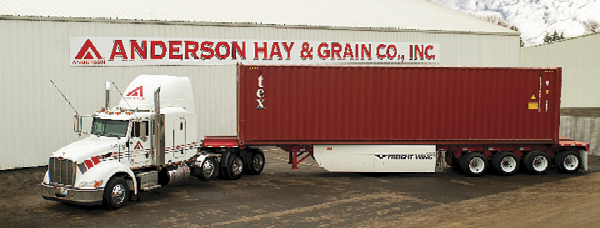Aerodynamic Trailer Add-ons Make Fuel Savings a Breeze

High transportation costs were a drag for Anderson Hay & Grain, until it installed aerodynamic trailer side skirts to increase fuel efficiency.
Just as Rumpelstiltskin could spin straw into gold, Anderson Hay & Grain Co. Inc. can turn straw and grass grown on the U.S. West Coast into an important export commodity that earns a profit. Anderson provides customers in the Pacific Rim and Middle East markets high-quality feed hay and straw products for raising racehorses, dairy cows, beef cattle, and camels.
A leading exporter of timothy hay, alfalfa hay, and grass straw products, Anderson Hay & Grain operates hay processing facilities at three divisions located in Ellensburg, Wash., Wilmington, Calif., and Aurora, Ore. The third-generation, family-owned company, headquartered in Ellensburg, grows and harvests hay and straw on farmland across the western United States. To complete its export product supply base, the company also teams with a grower network of family-owned farms in the same regions that specialize in hay and straw production.
Anderson Hay & Grain uses flatbeds to haul hay and straw bales inbound from the fields to its processing facilities, where it is "double-compressed" for overseas shipping in containers. The products travel via container chassis from the processing facilities to the ports of Seattle and Tacoma, Wash.; Portland, Ore., and Los Angeles and Long Beach, Calif.
The tractor-trailers typically run at 102,000 pounds in Washington and Oregon, and at 95,000 pounds in California. The company owns 25 trucks in Washington, nine in California, and four in Oregon, and uses contracted haulers to fulfill additional transportation needs.
One of Anderson Hay’s biggest logistics challenges is controlling transportation costs, primarily in Washington and Oregon, where hay must travel hundreds of miles from processing facilities to the ports. (Transport costs are less of a concern in California, where the company’s processing facility is only four miles from the Los Angeles and Long Beach ports.)
While Anderson Hay does not have much control over its ocean shipping costs, the company can manage its over-the-road transportation costs.
"We’re always looking for ways to reduce costs through fuel savings and other strategies, because profit margins are tight," says Alan Fife, facilities manager for Anderson Hay. "We considered switching to super singles (wide-base tires). But the cost of retrofitting truck and trailer axles to fit the tires would cancel out the fuel savings the new equipment would generate. We wanted to find a greater bang for our buck."
Got It Covered
Fife evaluated several potential equipment improvements, including aerodynamic trailer side skirts for the tractor-trailer units running in Washington and Oregon.
Side skirts are panels that hang from the sides of a trailer’s bottom edge to cover the open space between the rear wheels of the tractor and the rear wheels of the trailer; enclosing the space decreases wind resistance, increasing fuel efficiency.
Trailer side skirts offered promise for Anderson Hay because of the distances the truck and trailer units travel in Washington and Oregon. In Washington, for example, the company’s trailer chassis travel 110 miles to the Seattle port and 130 miles to Tacoma, twice daily, representing a distance of almost 500 miles per unit, per day.
The problem with using side skirts was finding one that could attach to an intermodal chassis and still offer the more than four-percent fuel economy improvement trailer van body operators typically report with EPA SmartWay-verified skirts.
For a solution, Fife turned to Anderson Hay’s trailer manufacturer and dealer, Grandview, Wash.-based Dionbilt Trailers. Dionbilt worked with FreightWing, a Seattle-based aerodynamics company, to develop a new design and solution.
FreightWing created trailer skirts designed specifically for chassis trailers, and made of light, flexible, durable, and dense matrix polyethylene material. The skirt clamps to the I-beams just below where the intermodal box rests.
Installing the FreightWing trailer skirts improved Anderson Hay’s fuel economy by five to seven percent, contributing an annual savings of about $100,000, and a fast payback of nine months.
Combined with other fuel-efficiency initiatives—including fleet management software, aerodynamic roof fairings, driver training, and speed governor adjustments—the company now gets an average of one additional mile per gallon of fuel. This may not sound like much, until you consider that its trucks use more than half a million gallons of fuel annually.
"The fuel cost savings help keep transportation costs down, and allow us to offer competitively priced products," Fife says.
The Green Advantage
By burning less fuel getting product to ports, Anderson is also reducing its supply chain’s impact on the environment. "That green advantage is becoming increasingly important to our customers," Fife says.
The transportation cost savings and sustainability improvements couldn’t have come at a better time for Anderson Hay.
"Our business is expanding because of growing demand for dairy products from a rapidly expanding middle class in countries such as China," says Rodney Van Orman, operations manager at Anderson Hay & Grain. "We take pride in supplying high-quality hay products, and finding ways to do it cost-efficiently and sustainably."
